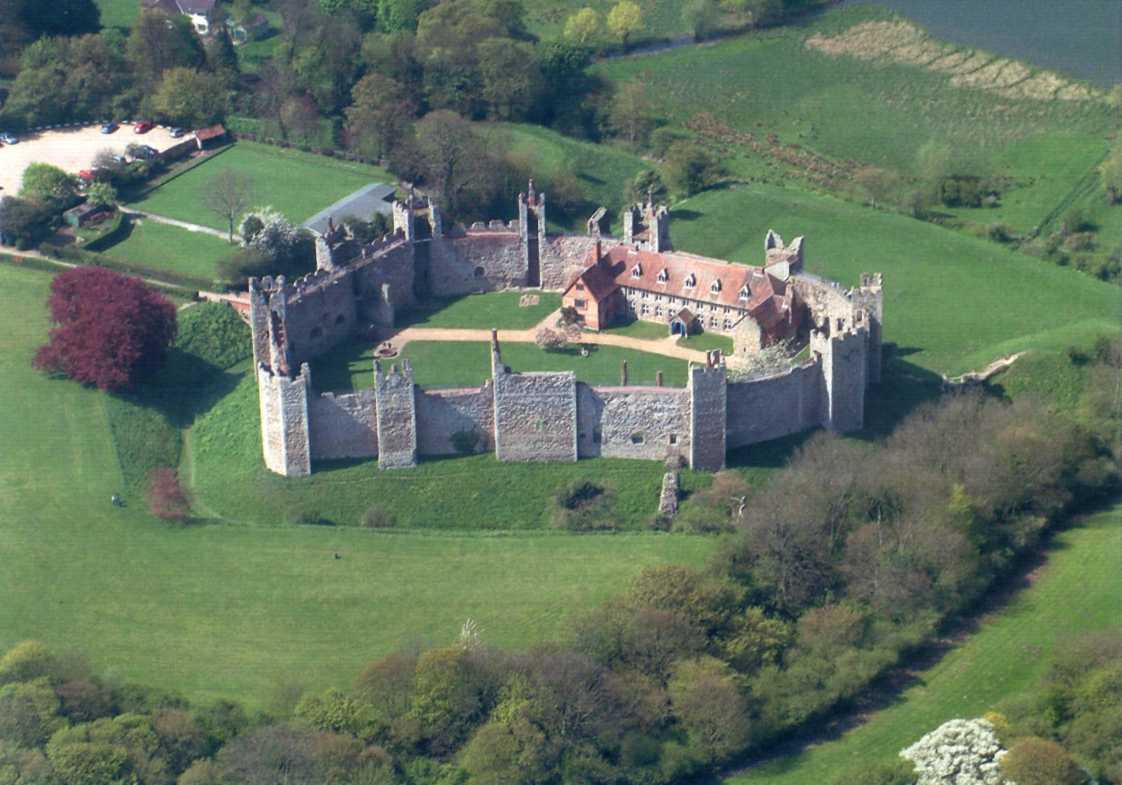There are claims made that the first fortifications at Framlingham were constructed in the reign of King Edmund (855-70) and that these were overrun by the Danes. There appears to be little evidence to support this. Part of a Saxon cemetery has been discovered under the footpath which leads from the car park to the castle, but the dress ornaments arc of the eighth century and so do not support this theory.
The first definite records are of 1101 when the manor of Framlingham was granted to Roger Bigod. A wooden tower would have been quickly constructed on a mottc which probably stood where the present poorhouse is (the ground here shows evidence of considerable disturbance), surrounded by a ditch and wooden palisade. This provided Bigod with a strong wall of defences with his castles at Bungay, Ipswich and Walton (built around 1135). The latter had almost certainly been converted to stone by 1140 when Hugh Bigod was created Earl of Norfolk and Suffolk. In 1157 Bigod had to surrender his castles to King Henry II and a royal garrison was stationed here. Sometime between 1158 and 1173, the king returned Bungay and Framlingham to Hugh Bigod. Bigod commenced massive building work at Bungay and almost certainly strengthened Framlingham. All that remains of this period are part of the walls on the eastern side and the columns of the bridge of the original entrance to the castle. The year 1173 saw the rebellion by Hugh and Henry IPs eldest son against the king (see p. 45). Alnodus the royal engineer was paid to demolish Framlingham and very little was left standing.
In the ll80s Hugh Bigod’s son, another Roger, regained his father’s estates and rebuilt Framlingham in stone. He was a loyal supporter of King Richard but not his brother John. John besieged the castle in March 1216 and the surrender was taken after two days. There were 53 fighting men, a priest
TYPE
Enclosure
OWNERSHIP English Heritage

And two otiicrs. The castle was again restored to the Bigods in the reign of Edward I. The estates went to the king in 1307.
The king maintained control of Framlingham for the next century until it was given to Thomas Mowbray in 1397 by Richard II. Mowbray had been made Duke of Norfolk. The castic then reverted to the throne when Thomas was exiled and his son executed for attempting a rebellion against Henry V. Thomas’s brother John was given the title Duke of Norfolk in 1425 and the family retained Framlingham until it passed to the Howard family around 1482. The worn Howard arms can still be seen over the entrance to the castle. John Howard died at the Battle of Bosworth in 1485. His son, Thomas, also a Yorkist supporter, was captured at the battle but restored to favour in 1513 after leading the king’s army at the Battle of Floddcn in Northumberland. Thomas’s brother Edmund also led the right flank at the battle. Thomas Howard featured prominently during the reign of Henry VIII and was mainly responsible for the downfall of Thomas Cromwell. However, his political aspirations were quickly crushed after the discovery of Catherine Howard’s adultery. His son was executed and he was sentenced to death, but the king died on 23rd January 1547, the night before Howard’s execution, and so he was granted a reprieve. In 1553 Framlingham was granted to Mary Tudor by her brother Edward VI.
Framlingham’s greatest year was 1553, when Mary Tudor stayed at the castle whilst her enemies plotted to bring the young innocent Lady Jane Grey to the throne. (Lady Jane’s grandmother was Mary ‘Rose’ Tudor, who is buried in St Mary’s Church, Bury St Edmunds.) The plot collapsed when thirteen thousand supporters led, amongst others, by Suffolk knights Drury, Cornwallis, Shelton and Tyrcll came to Framlingham to proclaim Mary the rightful queen. Mary marched into London unopposed to cheering crowds. Yet by the end of her reign six years later, thirty-six people had died at the stake in Suffolk alone. Visitors to Framlingham Castle in the 17th century used to be told that whilst at Framlingham she had given birth to a monster, which she smashed against a stone in the lower court.
The Flowards no longer used Framlingham as their main residence, moving instead to Kcnning-hall in Norfolk. During the reign of Elizabeth the castle was used as a prison for Recusants (those who defied the authority of the Church of England). In December 1600, 36 prisoners were sent manacled in pairs from Wisbech to Framlingham, escorted by 30 soldiers. When they had reached Ely the Keeper discovered that he was responsible

For paying for the soldiers’ upkeep. As this was going to be rather expensive he refused to pay and had to rely on the word of a Father Bluett, who promised that they would be at Framlingham on time. Unescorted, the prisoners duly arrived. However the castle was not ready for them and so for the first two months some of the Recusants had to find lodgings in local villages. The castle remained a prison for Recusants until 1603. In 1635 the castle was sold to Sir Robert Hitcham, but he died one year later and the castle eventually (after considerable controversy about the will) went to the ownership of Pembroke College, Cambridge. Around this time most of the stones from the buildings in the bailey were reused. Some went to Southwold to help with rebuilding work after a great tire, some were used for building schools and almshouses at Dcbcnham, Coggeshall and Framlingham. In 1664 a workhouse was built; luckily the walls were left intact.
The workhouse was converted and rebuilt as the parish poorhouse in 1729. This was used until 1839, after which it was used as a store, courthouse, fire station and assembly rooms. In 1913 the castle was given over to the state as a national monument.




 World History
World History









